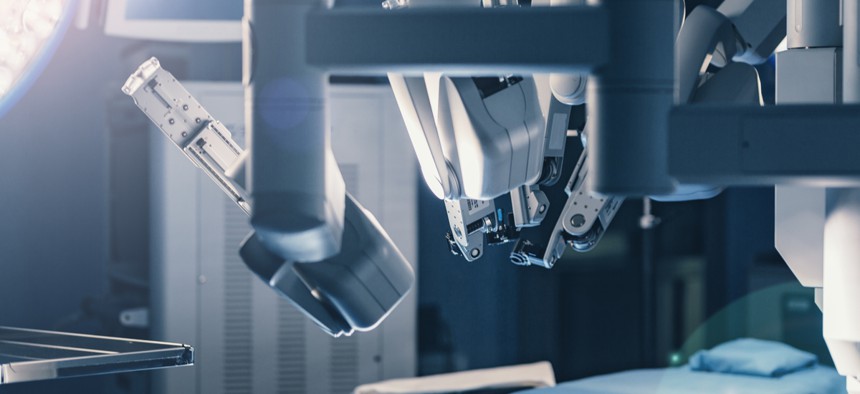Robotic Surgeries Are Changing the Game Inside One VA Facility

MAD.vertise/Shutterstock.com
More than 60 robotics-boosted surgical procedures were performed since March—and the program will likely expand in the next year.
Patients who undergo operations on organs inside their chests—thoracic surgeries—often endure long recovery periods and invasive procedures doctors perform intricately by hand.
But for some of those surgeries this year at the Columbia Veterans Affairs Health Care System in South Carolina, incisions were made and patients’ insides were mended by the arms of a robot.
The Da Vinci XI robotic surgical system has been assisting the Veterans Affairs Department’s medical personnel there with procedures for months now, and according to those involved, it’s enabling a new level of precision and accelerating patients’ recoveries.
“Overwhelming evidence has shown certain operations have equal or better surgical results using the robot compared to traditional methods,” Dr. JW R. Bolton, chief of surgery at the Columbia VA HCS, told Nextgov via email Friday. “The Columbia VA wanted to provide veterans with the latest, state-of-the-art technology found at other private sector hospitals and improve our patient care for veterans in need of surgery.”
The health care system’s surgery department explored the possibility of introducing a robotics-driven surgical program over the course of a few years, and building on that, the broader Columbia-based system worked directly with VA Central Office more recently to establish the new program within the facility. Bolton explained that at the end of fiscal year 2019, an opportunity arose to purchase the robotic surgical system for approximately $2.3 million through facility funds, which was subsequently reviewed and approved.
More traditional methods of thoracic procedures can require long, uncomfortable stays at the hospital and much more than what happens via this assistive machine. In this method, the robot is steered by the surgeon “from an arcade-like control panel,” as VA’s release put it. The technological tool is able to make four small incisions—about the size of a paperclip—through which its four robotic arms are inserted.
“Since March 2020, the Columbia VA’s robotic surgical program has completed more than 60 robotic surgeries,” Bolton said. “In such a short amount of time, the Columbia VA has been able to provide our veterans with spectacular outcomes with these surgeries, greatly improving their quality of life.”
One recent robotic surgery patient treated by the system in Columbia is Army National Guard Veteran Reginald Thomas, whose military service spanned from 1988 to 1996, and included a combat tour in Operation Desert Storm. An operation was performed using the robot to remove a mass in his chest on a Thursday—and he was discharged on Friday.
“I wanted to mow the yard on Saturday but my wife wouldn’t let me. In the past, my surgery would’ve required having my chest cracked open,” Thomas said in VA’s release. “Not anymore. This robotic surgery at VA is the only way to go.”
Army Veteran Wayne Bowers also underwent thoracic robotic surgery at Columbia VA and was able to return to normal activities within two days, without narcotic pain medication.
“I would be confident in recommending this type of surgery to anyone who needed it,” Bowers said.
Beyond just treating patients, the health care system also operates as a teaching institution. Having the Da Vinci XI robotic surgical system advances its aim to provide the latest technology available for training and educating the newest cohort of doctors and residents, Bolton noted.
And in 2021, all officials involved intend to build upon the less-than-a-year old robotic surgical program in substantial ways.
“The Columbia VA is looking to grow the number of eligible robotic surgical cases for general surgery (for example: colon, gastric, and hernias) and thoracic cases (for example: lung and esophagus),” Bolton said in the email. “Additional growth could stem from the hiring of additionally highly-specialized and trained urologists, gynecologists, colorectal, and general surgeons.”
While the health care system is always screening for competitive and qualified job applicants for these specific skill-sets, the medical chief confirmed that no additional robots are needed at this time.
“As the program progresses, we hope to keep emphasizing and promoting this surgical method to maximize the results for our veterans,” Bolton said.






